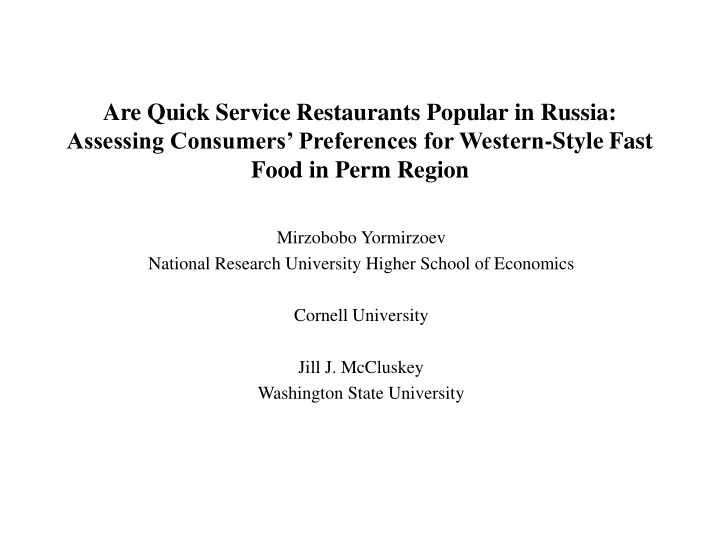

Are Quick Service Restaurants Popular in Russia: Assessing Consumers’ Preferences for Western -Style Fast Food in Perm Region Mirzobobo Yormirzoev National Research University Higher School of Economics Cornell University Jill J. McCluskey Washington State University
Research Background It was January 1990 when McDonald’s, a leading US fast food company opened its first branch in Moscow, USSR capital that attracted hundreds of Soviet customers who never had any opportunity to eat Western style fast food. After a quarter of century passed since then a number of fast food chains opened and operate successfully in different cities of Russia. Does fast food popular remain popular in Russia? In this article we seek to evaluate consumer attitudes and preferences for eating fast food in Perm that is located in country's Ural region.
Methodology The contingent valuation method (CVM) will be applied to estimate willingness to pay (WTP). This method is widely used for assessing individual WTP based on the responses of market-type questions with binary choices (Kanninen, 1993). The planned survey for this study will comprise CV questions regarding respondents’ willingness to pay a premium or accept a discount in order to purchase and eat Western-style fast food.
Methodology We will use a double-bounded binary choice model to evaluate respondents’ outcomes from the survey (Hanemann et.al, 1991). There will be four possible results in the model: Respondents are not willing to eat fast food at the same price as Russian traditional food (pelmeni) and they are not willing to eat it even at a discount price (NO followed by NO). Respondents are not willing to eat fast food at the same price as Russian traditional food (pelmeni) but under a given random discount they are willing to eat fast food (NO followed by YES). Respondents are willing to eat fast food at the same price as Russian traditional food (pelmeni) but are not willing to eat fast food at a higher price (YES followed by NO). Respondents are willing to eat fast food at the same price as Russian traditional food (pelmeni) and they are willing to eat it at a randomly assigned premium (YES followed by YES).
Methodology The WTP function is represented in the following form: WTP = α - τ B+ λ `z+ ε where B is the ultimate bid amount each respondent faces, z is a column vector of observable characteristics of the individual respondent, ε is a random variable that comprises unobservable characteristics, and α , τ and λ are unknown parameters to estimated . In the empirical implementation of the model, we define G(.) to be the standard logistic distribution with mean zero and standard deviation σ = π / √3. The maximum likelihood method (MLM) will be used to estimate the equation.
Data and Sample We hope to get data for the study from NRU HSE – Perm. Respondents will be faculty members, staff and students. It would adequate should we cover about 15 or 20% of campus population for this article. Several socio-demographic as well as consumer perception variables will be requested from respondents.
Data and Sample Socio-Demographic Variables: Age, Gender, Marital Status, Years of Education, Household Monthly Income, Children under 18 in household, student, faculty, staff, respondent from Perm or not. Consumer Perception Variables : opinion, safety, risk, taste, price, restaurant location, frequency of fast food eating, etc.
Tentative Article Content Introduction Fast Food Consumption in Russia Related Studies Survey Data Methodology Empirical Results Conclusions References
Are Quick Service Restaurants Popular in Russia: Assessing Consumers’ Preferences for Western -Style Fast Food in Perm Region Thank you for your attention. Your suggestions and inputs are welcomed.
Recommend
More recommend